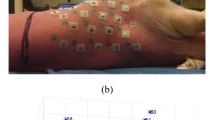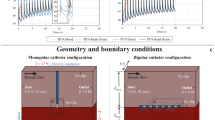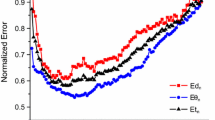Abstract
Radiofrequency catheter ablation (RCA) procedures for treating ventricular arrhythmias have evolved significantly over the past several years; however, the use of RCA has been limited due to the difficulty in identifying the appropriate site for ablation. In this study, we investigate the accuracy of a computer algorithm to guide the tip of an ablation catheter to the exit site of the scar tissue or the site of abnormal automaticity (the “target site”). This algorithm involves modeling the body surface potentials corresponding to the wavefront at the target site for ablation and current pulses generated from a pair of electrodes at the tip of the ablation catheter with a single equivalent moving dipole (SEMD) in an infinite homogeneous volume conductor. Despite the fact that the use of the homogeneous volume conductor introduces systematic error in the estimated compared to the true dipole location, we find that the systematic error had minor influence in the ability of the algorithm to accurately guide the tip of the ablation catheter to the ablation site and the overall error (1.9 ± 1.1 mm) in the left ventricle is adequate for RCA procedures. These results were verified, in saline tank studies in which the distance between the dipole due to the catheter tip and the dipole due to the target site was found to be 2.66 ± 0.52 mm. In conclusion, our algorithm to estimate the SEMD parameters from body surface potentials can potentially be a useful method to rapidly and accurately guide the catheter tip to the arrhythmic site during an RCA procedure.







Similar content being viewed by others
References
Armoundas AA, Feldman AB, Sherman DA, Cohen RJ (2001) Applicability of the single equivalent point dipole model to represent a spatially distributed bio-electrical source. Med Biol Eng Comput 39(5):562–570. doi:10.1007/BF02345147
Armoundas AA, Feldman AB, Mukkamala R, Cohen RJ (2003) A single equivalent moving dipole model: an efficient approach for localizing sites of origin of ventricular electrical activation. Ann Biomed Eng 31(5):564–576. doi:10.1114/1.1567281
Armoundas AA, Feldman AB, Mukkamala R, He B, Mullen TJ, Belk PA, Lee YZ, Cohen RJ (2003) Statistical accuracy of a moving equivalent dipole method to identify sites of origin of cardiac electrical activation. IEEE Trans Biomed Eng 50(12):1360–1370. doi:10.1109/TBME.2003.819849
Berger T, Fischer G, Pfeifer B, Modre R, Hanser F, Trieb T, Roithinger FX, Stuehlinger M, Pachinger O, Tilg B, Hintringer F (2006) Single-beat noninvasive imaging of cardiac electrophysiology of ventricular pre-excitation. J Am Coll Cardiol 48(10):2045–2052. doi:10.1016/j.jacc.2006.08.019
Bogun F, Kim HM, Han J, Tamirissa K, Tschopp D, Reich S, Elmouchi D, Igic P, Lemola K, Good E, Oral H, Chugh A, Pelosi F, Morady F (2006) Comparison of mapping criteria for hemodynamically tolerated, postinfarction ventricular tachycardia. Heart Rhythm 3(1):20–26. doi:10.1016/j.hrthm.2005.09.014
Cheng LK, Sands GB, French RL, Withy SJ, Wong SP, Legget ME, Smith WM, Pullan AJ (2005) Rapid construction of a patient-specific torso model from 3D ultrasound for non-invasive imaging of cardiac electrophysiology. Med Biol Eng Comput 43(3):325–330. doi:10.1007/BF02345808
de Chillou C, Lacroix D, Klug D, Magnin-Poull I, Marquie C, Messier M, Andronache M, Kouakam C, Sadoul N, Chen J, Aliot E, Kacet S (2002) Isthmus characteristics of reentrant ventricular tachycardia after myocardial infarction. Circulation 105(6):726–731. doi:10.1161/hc0602.103675
Fukuoka Y, Oostendorp TF, Sherman DA, Armoundas AA (2006) Applicability of the single equivalent moving dipole model in an infinite homogeneous medium to identify cardiac electrical sources: a computer simulation study in a realistic anatomic geometry torso model. IEEE Trans Biomed Eng 53(12 Pt 1):2436–2444. doi:10.1109/TBME.2006.880882
Gepstein L, Hayam G, Ben-Haim SA (1997) A novel method for nonfluoroscopic catheter-based electroanatomical mapping of the heart. In vitro and in vivo accuracy results Circulation 95(6):1611–1622
Gornick CC, Adler SW, Pederson B, Hauck J, Budd J, Schweitzer J (1999) Validation of a new noncontact catheter system for electroanatomic mapping of left ventricular endocardium. Circulation 99(6):829–835
Huiskamp G, Van Oosterom A (1988) The depolarization sequence of the human heart surface computed from measured body surface potentials. IEEE Trans Biomed Eng 35(12):1047–1058. doi:10.1109/10.8689
Langberg JJ, Harvey M, Calkins H, el-Atassi R, Kalbfleisch SJ, Morady F (1993) Titration of power output during radiofrequency catheter ablation of atrioventricular nodal reentrant tachycardia. Pacing Clin Electrophysiol 16(3 Pt 1):465–470. doi:10.1111/j.1540-8159.1993.tb01609.x
Lee MA, Morady F, Kadish A, Schamp DJ, Chin MC, Scheinman MM, Griffin JC, Lesh MD, Pederson D, Goldberger J (1991) Catheter modification of the atrioventricular junction with radiofrequency energy for control of atrioventricular nodal reentry tachycardia. Circulation 83(3):827–835
Modre R, Tilg B, Fischer G, Hanser F, Messnarz B, Seger M, Schocke MF, Berger T, Hintringer F, Roithinger FX (2003) Atrial noninvasive activation mapping of paced rhythm data. J Cardiovasc Electrophysiol 14(7):712–719
Nademanee K, Kosar EM (1998) A nonfluoroscopic catheter-based mapping technique to ablate focal ventricular tachycardia. Pacing Clin Electrophysiol 21(7):1442–1447. doi:10.1111/j.1540-8159.1998.tb00216.x
Nelder JA, Mead R (1965) A Simplex method for function minimization. Comput J 7:308–313
Okishige K, Kawabata M, Umayahara S, Yamashiro K, Gotoh M, Isobe M, Strickberger SA (2003) Radiofrequency catheter ablation of various kinds of arrhythmias guided by virtual electrograms using a noncontact, computerized mapping system. Circ J 67(5):455–460. doi:10.1253/circj.67.455
Peeters HA, SippensGroenewegen A, Wever EF, Ramanna H, Linnenbank AC, Potse M, Grimbergen CA, van Hemel NM, Hauer RN, Robles de Medina EO (1999) Clinical application of an integrated 3-phase mapping technique for localization of the site of origin of idiopathic ventricular tachycardia. Circulation 99(10):1300–1311
Ramanathan C, Ghanem RN, Jia P, Ryu K, Rudy Y (2004) Noninvasive electrocardiographic imaging for cardiac electrophysiology and arrhythmia. Nat Med 10(4):422–428. doi:10.1038/nm1011
Ramanathan C, Jia P, Ghanem R, Ryu K, Rudy Y (2006) Activation and repolarization of the normal human heart under complete physiological conditions. Proc Natl Acad Sci USA 103(16):6309–6314. doi:10.1073/pnas.0601533103
Schilling RJ, Davies DW, Peters NS (1998) Characteristics of sinus rhythm electrograms at sites of ablation of ventricular tachycardia relative to all other sites: a noncontact mapping study of the entire left ventricle. J Cardiovasc Electrophysiol 9(9):921–933. doi:10.1111/j.1540-8167.1998.tb00133.x
Schilling RJ, Peters NS, Davies DW (1998) Simultaneous endocardial mapping in the human left ventricle using a noncontact catheter: comparison of contact and reconstructed electrograms during sinus rhythm. Circulation 98(9):887–898
Smith NP, Buist ML, Pullan AJ (2003) Altered T wave dynamics in a contracting cardiac model. J Cardiovasc Electrophysiol 14(Suppl 10):S203–S209. doi:10.1046/j.1540.8167.90312.x
Stevenson WG, Khan H, Sager P, Saxon LA, Middlekauff HR, Natterson PD, Wiener I (1993) Identification of reentry circuit sites during catheter mapping and radiofrequency ablation of ventricular tachycardia late after myocardial infarction. Circulation 88(4 Pt 1):1647–1670
Stevenson WG, Sager PT, Natterson PD, Saxon LA, Middlekauff HR, Wiener I (1995) Relation of pace mapping QRS configuration and conduction delay to ventricular tachycardia reentry circuits in human infarct scars. J Am Coll Cardiol 26(2):481–488. doi:10.1016/0735-1097(95)80026-D
Stevenson WG, Delacretaz E, Friedman PL, Ellison KE (1998) Identification and ablation of macroreentrant ventricular tachycardia with the CARTO electroanatomical mapping system. Pacing Clin Electrophysiol 21(7):1448–1456. doi:10.1111/j.1540-8159.1998.tb00217.x
van Oosterom A, van Dam RT (1976) Potential distribution in the left ventricular wall during depolarization. Adv Cardiol 16:27–31
Zhang X, Ramachandra I, Liu Z, Muneer B, Pogwizd SM, He B (2005) Noninvasive three-dimensional electrocardiographic imaging of ventricular activation sequence. Am J Physiol Heart Circ Physiol 289(6):H2724–H2732. doi:10.1152/ajpheart.00639.2005
Acknowledgments
The work was supported by a Beginning Grant-in-Aid (#0365304U) and a Scientist Development Grant (#0635127 N) American Heart Association awards.
Author information
Authors and Affiliations
Corresponding author
Rights and permissions
About this article
Cite this article
Fukuoka, Y., Oostendorp, T.F. & Armoundas, A.A. Method for guiding the ablation catheter to the ablation site: a simulation and experimental study. Med Biol Eng Comput 47, 267–278 (2009). https://doi.org/10.1007/s11517-009-0441-4
Received:
Accepted:
Published:
Issue Date:
DOI: https://doi.org/10.1007/s11517-009-0441-4




